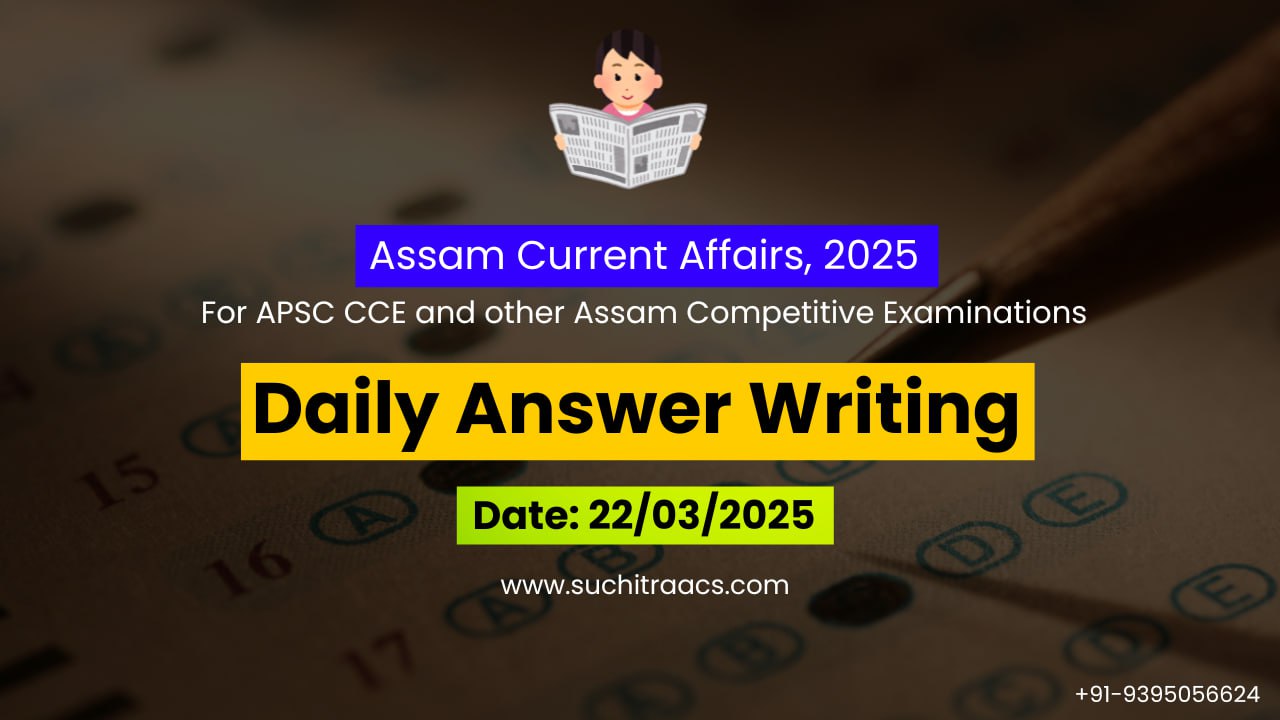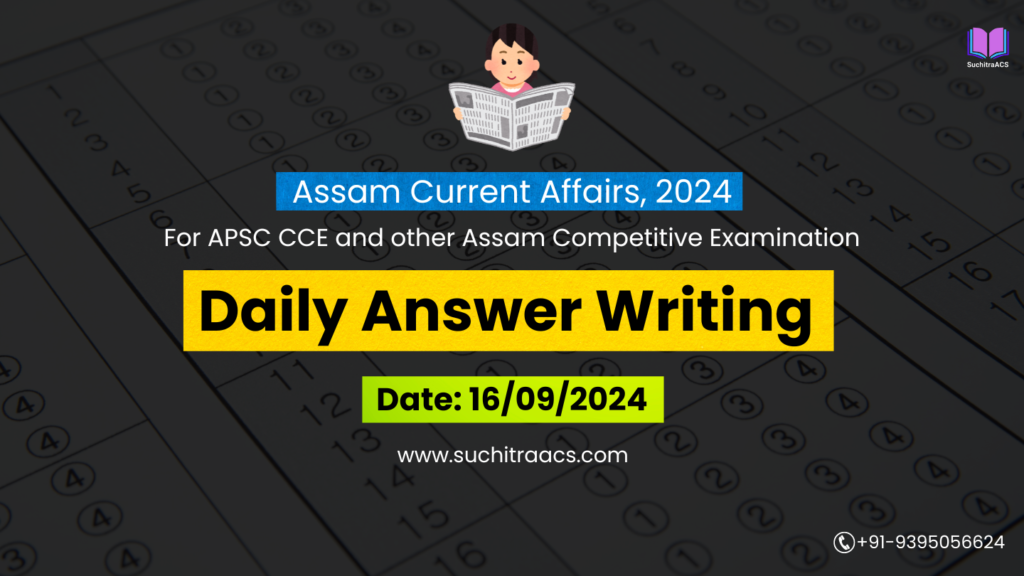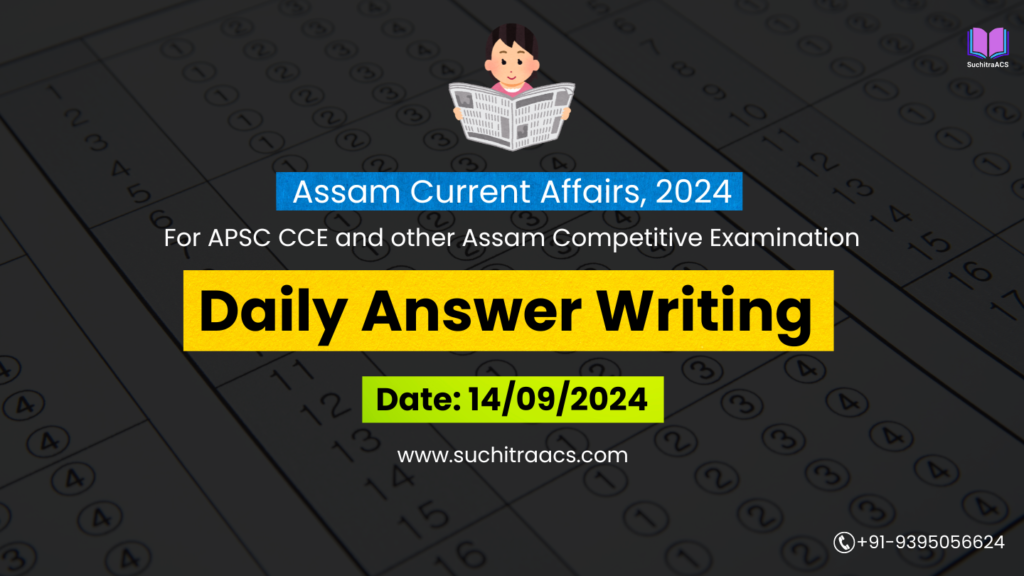APSC Answer Writing (Daily) based on Assam Tribune – 22/03/2025
For APSC CCE and other Assam Competitive examinations aspirants, practicing Daily Answer Writing is vital. This blog covers the most important Main question and its model Answer from the Assam Tribune today (22-03-2025).
Mains Question
“With the increasing frequency of floods in Assam, there is a need for technological solutions to improve disaster preparedness and response. Discuss the role of AI-based Flood Early Warning Systems (FEWS) in mitigating flood damage. Also, suggest measures to enhance disaster resilience in Assam.” (GS Paper 3: Disaster Management, Science & Technology, Climate Change)
Model Answer
Introduction
Assam faces severe annual floods due to monsoon rains, Brahmaputra River overflow, and climate change impacts. These floods lead to loss of lives, economic damage, displacement of millions, and destruction of agriculture and infrastructure.
The introduction of AI-based Flood Early Warning Systems (FEWS) aims to improve flood prediction, enhance real-time monitoring, and enable proactive disaster management. However, successful implementation requires addressing technological, financial, and infrastructural challenges.
Role of AI-Based Flood Early Warning Systems in Flood Management
✅ 1. Real-Time Data Collection & Analysis
- AI integrates data from satellites, river sensors, and weather forecasts to predict flood patterns.
- Advanced hydrological models analyze rainfall, soil moisture, and river flow changes.
✅ 2. Accurate Flood Forecasting & Prediction
- Machine learning algorithms detect early signs of rising water levels and forecast potential flooding.
- Improves prediction accuracy compared to traditional forecasting methods.
✅ 3. Automated Alert Systems for Faster Evacuation
- AI-powered systems send automatic alerts to disaster management authorities and the public.
- Early warnings reduce response time and prevent casualties.
✅ 4. Decision Support for Disaster Management Agencies
- Helps the National Disaster Response Force (NDRF) and Assam State Disaster Management Authority (ASDMA) in resource allocation.
- Identifies high-risk zones, allowing efficient deployment of rescue teams and relief materials.
✅ 5. Post-Disaster Assessment & Recovery Planning
- AI-driven damage assessment helps in quick response and efficient rehabilitation.
- Geospatial AI identifies areas needing urgent reconstruction.
Challenges in Implementing AI-Based Flood Warning Systems
✅ 1. Infrastructural & Connectivity Issues
- Many flood-prone areas lack advanced meteorological stations and sensors.
- Rural areas have limited internet access, restricting AI system functionality.
✅ 2. Data Limitations & Accuracy Concerns
- AI models require large datasets for accurate predictions, but historical flood data is often incomplete.
- Extreme weather events caused by climate change make flood patterns unpredictable.
✅ 3. High Implementation & Maintenance Costs
- Deploying AI systems involves high initial investment and technical expertise.
- Government funding constraints may slow adoption.
✅ 4. Lack of Skilled Manpower
- Local disaster management authorities require training in AI-based risk assessment tools.
- Limited collaboration between AI researchers and disaster response teams.
✅ 5. Public Awareness & Response Gaps
- Even with accurate AI warnings, public awareness on evacuation and preparedness is low.
- Need for better communication strategies to ensure people respond to alerts.
Measures to Enhance Disaster Resilience in Assam
✅ 1. Strengthening AI-Based Early Warning Infrastructure
- Expanding real-time flood monitoring networks in high-risk districts.
- Developing mobile-based AI alert systems for rural communities.
✅ 2. Integrating AI with Traditional Flood Management Techniques
- Combining AI predictions with embankments, flood control reservoirs, and wetland conservation.
- Restoring Assam’s wetlands and forests to naturally absorb excess rainwater.
✅ 3. Capacity Building & Training in AI for Disaster Management
- Training disaster response teams, local authorities, and NGOs on using AI tools.
- Collaborating with universities and tech firms for research in AI-driven disaster resilience.
✅ 4. Public-Private Partnerships (PPP) for Funding & Implementation
- Encouraging private sector investments in AI-based disaster tech.
- Utilizing CSR (Corporate Social Responsibility) funds for disaster management programs.
✅ 5. Strengthening Community Awareness & Local Participation
- Organizing flood drills and community workshops on early warning responses.
- Establishing village-level disaster response units trained in evacuation procedures.
Way Forward
✅ 1. Expanding AI Adoption Beyond Assam
- AI-driven flood management systems should be implemented in other flood-prone states.
✅ 2. International Collaboration in Disaster Technology
- Partnering with global agencies (WMO, NASA, JAXA) for improved flood forecasting models.
✅ 3. Improving Policy & Governance for AI-Based Disaster Management
- Developing a National AI-Driven Disaster Resilience Framework.
- Ensuring coordination between AI research institutions and disaster response agencies.
Conclusion
AI-based Flood Early Warning Systems can revolutionize disaster preparedness in Assam by enabling accurate predictions, faster response, and improved resilience strategies. However, strong policy support, infrastructural investment, and public awareness are crucial for maximizing its impact.
By integrating AI with traditional flood control measures, Assam can reduce disaster risks, protect livelihoods, and create a model for tech-driven disaster management in India.
✨ Looking for top-quality APSC Mains Guidance with Personalised Mentor?

🔔 Join Our WhatsApp Study Group!
For exclusive access to premium quality content, including study materials, current affairs, MCQs, and model answers for APSC CCE and other Assam competitive exams.
Click here to join: SuchitraACS Study WhatsApp Group
📚 Want to know more about SuchitraACS’s most affordable courses?
Click here to know more: SuchitraACS Courses for APSC CCE and Assam Competitive Examinations



